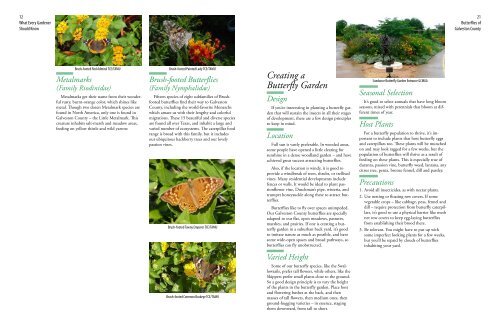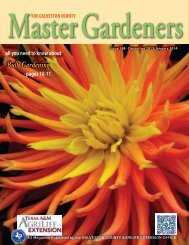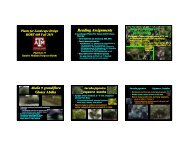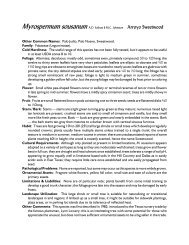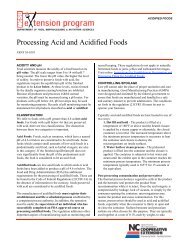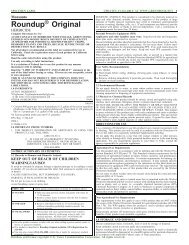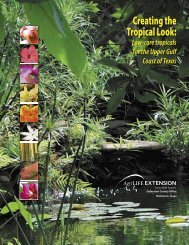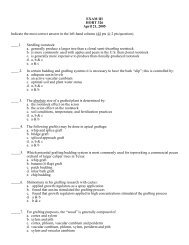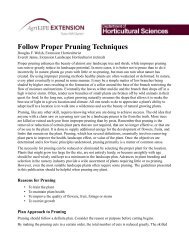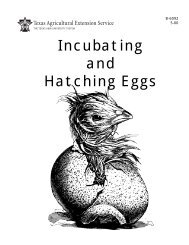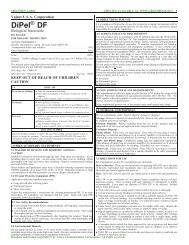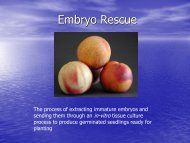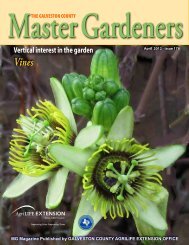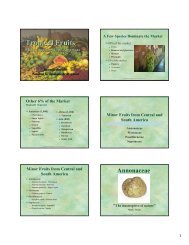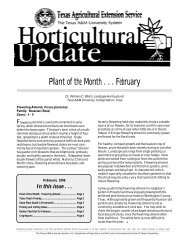12 What Every Gardener Should Know Brush-footed Red Admiral TCE/TAMU Brush-footed Painted Lady TCE/TAMU Metalmarks (Family Riodinidae) Metalmarks get their name from their wonderful rusty, burnt-orange color, which shines like metal. Though two dozen Metalmark species are found in North America, only one is found in <strong>Galveston</strong> <strong>County</strong> – the Little Metalmark. This creature inhabits salt-marsh and meadow areas, feeding on yellow thistle and wild yarrow. Brush-footed <strong>Butterflies</strong> (Family Nymphalidae) Fifteen species <strong>of</strong> eight subfamilies <strong>of</strong> Brushfooted butterflies find their way to <strong>Galveston</strong> <strong>County</strong>, including the world-favorite Monarchs which amaze us with their lengthy and colorful migrations. <strong>The</strong>se 15 beautiful and diverse species are found all over <strong>Texas</strong>, and inhabit a large and varied number <strong>of</strong> ecosystems. <strong>The</strong> caterpillar food range is broad with this family, but it includes our ubiquitous hackberry trees and our lovely passion vines. Brush-footed Tawny Emperor TCE/TAMU Brush-footed Common Buckeye TCE/TAMU Creating a Butterfly Garden Design If you’re interesting in planting a butterfly garden that will sustain the insects in all their stages <strong>of</strong> development, there are a few design principles to keep in mind. Location Full sun is vastly preferable. In wooded areas, some people have opened a little clearing for sunshine in a dense woodland garden – and have achieved great success attracting butterflies. Also, if the location is windy, it is good to provide a windbreak <strong>of</strong> trees, shrubs, or trellised vines. Many residential developments include fences or walls. It would be ideal to plant passionflower vine, Dutchman’s pipe, wisteria, and trumpet honeysuckle along these to attract butterflies. <strong>Butterflies</strong> like to fly over spaces unimpeded. Our <strong>Galveston</strong> <strong>County</strong> butterflies are specially adapted to our flat, open meadows, pastures, marshes, and prairies. If one is creating a butterfly garden in a suburban back yard, it’s good to imitate nature as much as possible, and have some wide-open spaces and broad pathways, so butterflies can fly unobstructed. Varied Height Some <strong>of</strong> our butterfly species, like the Swallowtails, prefer tall flowers, while others, like the Skippers prefer small plants close to the ground. So a good design principle is to vary the height <strong>of</strong> the plants in the butterfly garden. Place host and flowering bushes at the back, and then masses <strong>of</strong> tall flowers, then medium ones, then ground-hugging varieties – in essence, staging them downward, from tall to short. Sundance Butterfly Garden Entrance GCMGA Seasonal Selection It’s good to select annuals that have long bloom seasons, mixed with perennials that bloom at different times <strong>of</strong> year. Host Plants For a butterfly population to thrive, it’s important to include plants that host butterfly eggs and caterpillars too. <strong>The</strong>se plants will be munched on and may look ragged for a few weeks, but the population <strong>of</strong> butterflies will thrive as a result <strong>of</strong> feeding on these plants. This is especially true <strong>of</strong> duranta, passion vine, butterfly weed, lantana, any citrus tree, penta, bronze fennel, dill and parsley. Precautions 1. Avoid all insecticides, as with nectar plants. 2. Use netting or floating row covers. If some vegetable crops – like cabbage, peas, fennel and dill – require protection from butterfly caterpillars, it’s good to use a physical barrier like mesh net row covers to keep egg-laying butterflies from establishing their brood there. 3. Be tolerant. You might have to put up with some imperfect looking plants for a few weeks, but you’ll be repaid by clouds <strong>of</strong> butterflies inhabiting your yard. 21 <strong>Butterflies</strong> <strong>of</strong> <strong>Galveston</strong> <strong>County</strong>
20 What Every Gardener Should Know Nectar Plants for <strong>Butterflies</strong> TREES Flowering Senna, Cassia corymbosa Yellow flowers, late Summer-Fall, sun, drought tolerant, good drainage, size: 10’ Hackberry, Celtis spp. Native, deciduous, Host for Hackberry Emperor larvae. size: 20’ Jatropha, Peregrina, Jatropha integerrima Red or pink flowers Wild Olive, Cordia boissieri Native: White flowers, Spring-Fall, sun-part shade, tolerates moist soil, size: 15’ SHRUBS Butterfly Bush, Buddleia davidii Purple, lavender, white flowers Summer to Fall, sun to part shade, rich, well-drained soil, size: 5’-6’ Buttonbush, Cephalanthus occidentalis Cream or white flowers, sun to part shade, summer, good drainage, size: 6’-8’ Cape Honeysuckle, Tecomaria capensis Red flowers, Summer-Fall, full sun, root-hardy, drought tolerant, good drainage, size: 4’-8’ Golden Dewdrop, Duranta repens Lavender and white flowers, Summer to Fall, sun to part shade, good drainage, size: 5’-6’ Heartleaf Hibiscus, Hibiscus martianus Native: Red flowers, Spring-Fall, root-hardy, sun-part shade, tolerates moist soils, size: 2’ Lantana spp., L. camara, L. montevidensis, L. horrida, Native: several varieties with pink, lavender and orange flowers, Spring-Fall, sun-part shade, drought tolerant, good drainage, size: 3’-4’ Mexican Heather, Cuphea hysopifolia Pink, lavender and white flowers, Summer to Fall, drought tolerant, good drainage, size: 1’-2’ Red Yucca, Hesperaloe parviflora Red flowers, Summer-Fall, sun-part shade, drought tolerant, good drainage, size: 4’ <strong>Texas</strong> Sage, Leucophyllum frutescens Native: Purple flowers, before a rain in the Spring-Fall, sun-part shade, drought tolerant, good drainage, size: 3’-4’ Turk’s Cap, Malvaiscus arboreus, ‘Drummondii’ Native: Red flowers, late Spring-Fall, part shade-shade, root-hardy, drought tolerant, good drainage, size: 4’-5’ Yellow Bells, Tecoma stans, also called Esparanza Native: Yellow flowers, Spring-Fall, root-hardy, drought tolerant, good drainage, size: 4’-6’ VINES Coral Honeysuckle, Lonicera sempervirens Red flowers, sun-part shade, Spring-Fall, root-hardy, drought tolerant, good drainage, size: 18’ Maypop, Passiflora incarnata, also called ‘Passionflower’ Native: Purple, red or white, Spring-Fall, sun-shade, good drainage, edible fruit, size: 20’ Morning Glory, Ipomoea purpurea Red, blue and white flowers, Spring-Summer, full sun, good drainage, size: 10’-15’ Mexican Flame Vine, Senecio confuses Orange/red flowers, Spring-Fall, sun, root-hardy, good drainage, size: 20’ Mexican Honeysuckle, Justicia spicigera Red/orange flowers, Spring to Fall, sun-part shade, root-hardy, drought tolerant, good drainage, size: 12’ ANNUALS, BULBS AND PERENNIALS Asters, Aster spp., Annual - A. tanacetifolius, Perennial - A. frikartii Pink, purple, lavender, and white flowers through Summer and Fall, full sun, drought tolerant, good drainage, size: 2’-3’ Brown-eyed Susan, Rudbeckia hirta Native: Yellow flowers, Spring-Fall, sun-part shade, drought tolerant, size: 1’-2’ Butterfly Weed, Asclepias curassavica, also called ‘Mexican Oleander’ Native: Orange or Yellow flowers, full sun, root-hardy, drought tolerant, good drainage, size: 4’ Cannas, Canna ssp Pink, coral, yellow, red and yellow/red flowers, Summer to Fall, sun to shade, moist soils or gravel bog, size: 2’-6’ Coneflower, Echineacea purpurea Pink, white and lavender flowers, Spring to Fall, full sun to part shade, drought tolerant, good drainage, tolerates alkaline soils, size: 2’-3’ Cosmos, C. bipinnatus, C. sulphureus Pink, lavender, white, yellow and orange flowers from Summer to Fall, full sun, drought tolerant, good drainage, size: 4’-6’ Dahlberg Daisy, Dyssodia tenuiloba, Also called ‘Tiny Tim’ Native: Yellow flowers, full sun, drought tolerant, good drainage, reseeding annual, size: under 1’ Flame Acanthus, Anisacanthus quadrifidus Red flowers, Spring-Fall, root-hardy, full sun, good drainage, size: 3’-4’ Four Nerve Daisy, Tetraneuris scaposa Yellow flowers, Spring-Fall, full sun-part shade, good drainage, reseeding annual, size: 1 Gayfeather, Liatris elegans Native: Lavender flowers, late Summer-Fall, full sun, drought tolerant, tolerant <strong>of</strong> moist soils, bulb, size: 2’-3’ Goldenrod, Solidago spp. Native: yellow flowers late Summer-Fall, full sun to part shade, drought tolerant, tolerant <strong>of</strong> moist, alkaline soil, size: 5’-6’ Greenthread, <strong>The</strong>lesperma filifolium Yellow flowers, late Spring-Fall, full sun, good drainage, size: 2’ Horsemint, Monarda citriodora, also called ‘Lemon Mint’ Native: Lavender flowers, Spring-Summer, sun-part shade, drought tolerant, good drainage, reseeding annual, size: 1’-2’ Indian Blanket, Gaillardia pulchella, also called ‘Firewheel’ Native: Orange, red or yellow, Spring to Fall, sun-part shade, drought tolerant, good drainage, reseeding annual, size: 1’-2’ Indian Paintbrush, Castelleja indivisa Native: Red/Orange flowers, Spring, full sun, drought tolerant, good drainage, size: 1’-2’ Ironweed, Vernonia spp. Purple and pink flowers Joe Pye Weed, Eupatorium spp. Pink, lavender and white flowers, Summer to Fall, tolerates wet soils, size: 6’ Lazy Daisy, Aphanostephus skirrhobasis White flowers, Spring-Fall, sun-part shade, drought tolerant, good drainage, reseeding annual, size: 1’-2’ Mexican Sunflower, Tithonia rotundiflolia Yellow and orange flowers, Summer to Fall, full sun, drought tolerant, good drainage, reseeding annual, size: 4’ Mistflower, Eupatorium coelestinum Native: Lavender flowers, Summer-Fall, sun-part shade, root-hardy, drought tolerant, tolerates moist soil, size: 2’-3’ Penta, Penta lancelata Red, pink or lavender flowers, full sun-part shade, root-hardy, good drainage, size: 1’-2’ Phlox, Phlox spp. Pink, lavender and white flowers, late Spring to Fall, sun to part shade, good drainage, size: 12”-18” Pink Candle Celosia, Celosia cristata Pink or white flowers, Summer to Fall, Full sun, drought tolerant, good drainage, size: 4’-6’ Porter Weed, Stachytarpheta jamaicensis Purple, blue, red or coral flowers, Summer to Fall, part shade, good drainage, size: 2’-4’ Salvia, S. greggii, S. farinaceae, S. leucantha, S. coccinea Natives: Red, blue, purple or lavender flowers, full sun-part shade, drought tolerant, good drainage, size: 2’-4’ Skippers (Family Hesperiidae) Clouded Skipper USFWS Swarthy Skipper GCMGA Twenty-seven <strong>of</strong> the 83 butterflies that inhabit <strong>Galveston</strong> <strong>County</strong> are Skippers. Skippers get their name by the way they fly — fast, erratic, darting, and changing direction. <strong>The</strong>y are widely scattered across the East <strong>Texas</strong>. <strong>The</strong>ir larval food is almost exclusively grasses and sedges. Five species inhabit <strong>Galveston</strong> <strong>County</strong> and a few counties around it. Three species are found in <strong>Galveston</strong> <strong>County</strong> alone, not in any <strong>of</strong> the adjacent counties: <strong>The</strong> Mercurial Skipper, the Tailed Aguna, and the False Duskywing. Information For more exact information about and pictures <strong>of</strong> the 83 butterflies <strong>of</strong> <strong>Galveston</strong> <strong>County</strong>, readers should go directly to the USGS website: www.npwrc.usgs.gov/resource/DISTR/LEPID/ BFLYUSA/chklist/states/counties/tx_167.htm or www.google.com then type in the search engine: <strong>Butterflies</strong> <strong>Galveston</strong> <strong>County</strong> <strong>Texas</strong>. <strong>The</strong> page will come up immediately. One can then click on each individual butterfly on the list to bring up pictures <strong>of</strong> the egg, the caterpillar, the chrysalis, and the adult butterfly <strong>of</strong> that species, along with written information about its range, season, eating habits, and behavior. For those who don’t have Internet access, a fabulous book called the <strong>Butterflies</strong> <strong>of</strong> Houston & Southeast <strong>Texas</strong> by John and Gloria Tveten is available in area libraries and bookstores. <strong>The</strong> book contains very detailed information on each butterfly in our region, along with splendid color pictures <strong>of</strong> each. 13 <strong>Butterflies</strong> <strong>of</strong> <strong>Galveston</strong> <strong>County</strong>


